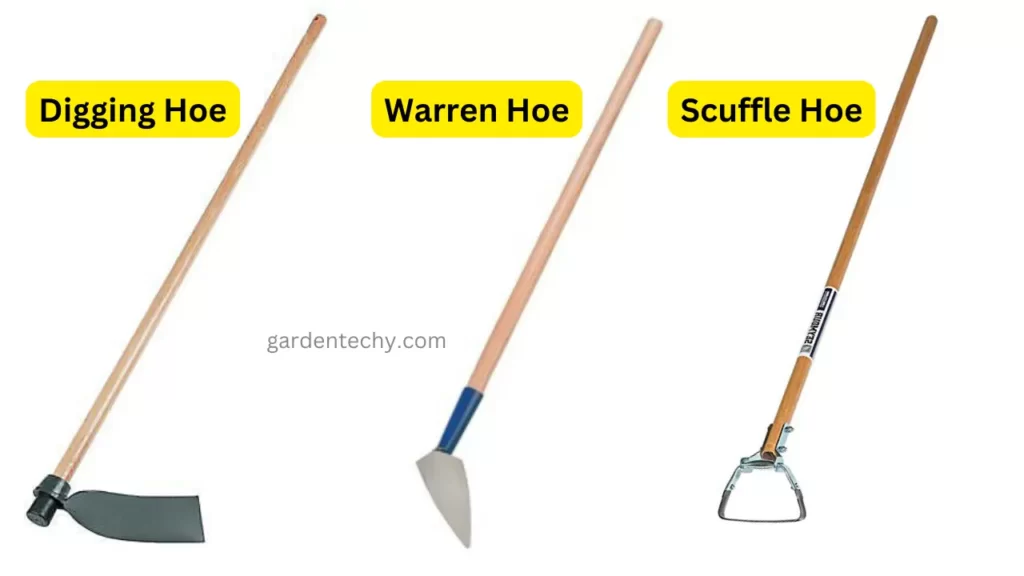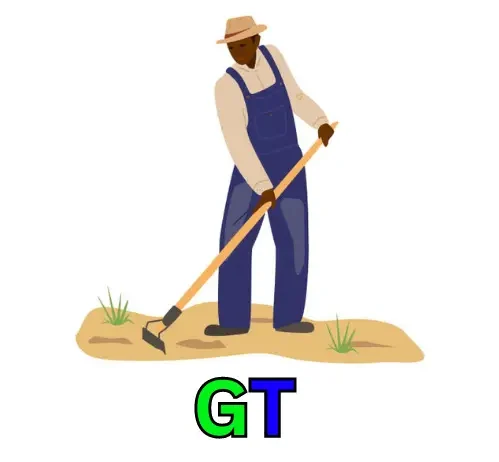Using different gardening tool for different gardening task make them easy but choosing the right gardening tool is an essential part of it. In Gardening the Hoes and Rakes are one of the most useful tools that every gardener should have.
Now both of these garden tools have their advantages and function which make them perfect for suitable gardening tasks. So, here in this article, we will know more about the difference between Hoes vs Rakes and which gardening tool is suitable for you depending on your gardening needs.
So, read till the end of this article to know all the features and functions of both of these tools which will help you to choose between them for your garden.

Hoes vs Rakes a Quick Comparison
| Garden Hoes | Graden Rakes |
|---|---|
| Primarily used for digging, weeding, and breaking up soil. | Mainly used for collecting debris, leveling surfaces, and spreading materials. |
| Have a long handle with a flat or slightly curved blade at one end. | Consist of a long handle with teeth or tines attached at one end. |
| Designed for tasks that require cutting through soil or weeds. | Designed for tasks that involve raking, gathering, or smoothing. |
| Different types include digging hoes, warren hoes, and scuffle hoes. | Different types include leaf rakes, garden rakes, and thatch rakes. |
| Effective for breaking up compacted soil and creating furrows. | Effective for collecting leaves, grass clippings, and lightweight debris. |
| Ideal for removing weeds and unwanted vegetation. | Ideal for leveling soil surfaces and spreading mulch or compost. |
| Blade shapes may vary, such as flat, triangular, or loop-shaped. | Tine materials can vary, including metal, plastic, or bamboo. |
| Suitable for smaller gardening areas and precise tasks. | Suitable for larger gardening areas and broader tasks. |
| Can be used to mix in organic matter and compost. | Can be used to remove thatch from lawns for healthier grass growth. |
| Can be used for cultivating and aerating the soil. | Can be used for removing stones and debris from garden beds. |
Also Read: Stirrup Hoe and Dutch Hoe which one is best for you
Hoe
A hoe is a long-handled tool gardening tool with a flat or slightly curved blade attached to an end that can be used to do multiple gardening tasks. Commonly the blade of the garden hoe is made of metal with different shapes and sizes depending upon the type of hoe. The other end of the hoe features a handle for gripping and maneuvering the tool.

Types of Hoes
Right now there are different types of garden hoes available in the market which are designed for each gardening task. So, here are the top 3 most common hoes used for gardening tasks.
- Digging Hoe: This type of hoe has a broad flat blade at the end of the handle which is suitable for breaking up soil, removing weeds, and digging trenches.
- Warren Hoe: This type of hoe has a unique triangle-shaped blade with a sharp point which make this hoe suitable for making furrows and planting seeds.
- Scuffle Hoe: The scuffle hoe is also known as the stirrup hoe, this type of hoe has a loop-shaped blade that moves back and forth, cutting the wed just below the soil surface.
These three hoes are the common type of hoes used for gardening tasks but there are much more types of gardening hoes available and you can know more about them in our gardening hoe guide article.
Common Uses of Hoes
A hoe can be used to do multiple gardening tasks and here is the some of the common use of hoes.
- Breaking up soil and preparing garden beds
- Removing weeds and unwanted vegetation
- Planting seeds and creating furrows
- Cultivating and aerating soil
- Mixing in organic matter and composter
Rakes
A rake is a useful gardening tool that has a long handle attached to a series of teeth or tines at one end. The tines of the rakes are commonly made of metal, plastic, or bamboo, and these tines can vary in length and flexibility depending on the type of rake. The handle provides leverage and control while using the rake.

Types of Rakes
Like the garden hoe the rake also have different types which are suitable for specific gardening tasks. So, here is the three most common rakes.
- Leaf Rake: The leaf rakes have flexible plastic or metal tines that are spaced wide apart. These tines are designed to collect leaves, lightweight debris, grass clippings, etc.
- Garden Rake: The garden rakes are also known as bow rakes, they have steady metal tines that are closer together. They are used for removing stones and debris, spreading mulch, and leveling soil.
- Thatch Rake: The thatch rakes have sharply curved tines that are designed to cut through and remove the layer of dead grass and roots known as thatch.
Common Uses of Rakes
The rakes can be used to do multiple gardening tasks such as
- Clearing grass clippers, leaves, and debris from lawn and grass beds.
- Leveling and smoothing soil surface.
- Spreading and distributing mulch, compost, or gravel
- Removing the thatch from lawns to promote healthy grass growth.
Also Read: How To Dethatch Bermuda Grass from different easy methods
Choosing the Right Tool Between Hoes & Rakes
Factors To Consider
To decide which gardening tool to choose make sure to consider the following factors
- Gardening Task: First note down all the gardening tasks you need to do at hand like digging, leveling, weeding, or collecting debris.
- Garden Size: The size of your garden is also important to consider while buying the tool in between them, The hoes are more suitable for the smaller areas while the rakes are suitable for the larger areas.
- Soil Type: Different soil types require different tools. Hoes are effective for breaking up compacted soil, while rakes work well for manipulating loose soil.
Matching tool to the task
We recommend gardeners have both of these gardening tools because both of these gardening tool can do different gardening tasks which the other cant do. The hoe is suitable for breaking up soil, digging trenches, and weeding. Where the rake is a perfect tool to do collecting debris, level surfaces, and spreading materials.
Tips for Using Hoes and Rakes Effectively
Proper Techniques for Using Hoes
Follow these steps to use the hoe effectively
- Hold the hoe with both hands, gripping the handle firmly.
- Position the blade at a slight angle to the ground.
- Use a back-and-forth motion to break up the soil or cut weeds.
- Apply pressure as needed, but avoid excessive force to prevent damage.
Proper Techniques for Using Rakes
Follow these steps to use the rake effectively
- Hold the rake with both hands, spacing them apart for better control.
- Keep the rake close to the ground, angling it slightly.
- Use a smooth pulling motion to collect debris or level the soil.
- Apply even pressure to avoid damaging the ground or plants.
Also Read: Half-Moon Edger vs Spade which one is best for your gardening
FAQs
Can I use a hoe to collect leaves?
Hoes are not designed to collect the leaves. Rakes especially leaf rakes are designed to collect leaves and they can collect the leave better than a hoe.
What is the best type of hoe for weeding?
A Stirrup or the scuffle hoe is the best tool for weeding. Where the stirrup hoes a unique blade design capable to remove the weed from just below the soil surface.
Can I use a garden rake to break up compacted soil?
No, a garden rake can help you to loosen the top layer of soil but a garden hoe can break up the soil more effectively than a garden rake.
Should I choose a metal or plastic rake?
Both metal and plastic rakes have their advantages. Metal rakes are sturdier and more durable, while plastic rakes are lighter and less likely to rust.
How often should I replace my garden rake or hoe?
With proper care, both hoes and rakes can last for several years. However, if you notice signs of wear, such as bent tines or handle damage, it’s advisable to replace them for optimal performance.
Conclusion
Booth of these gardening tools is capable to do specific gardening tasks which are essential tasks that gardeners should do on a daily basis. So, we recommend having both of these gardening tools in their inventory. But if you want to choose one of them, then list down the gardening tasks which you want to do and then choose the suitable tool which can do it properly.
